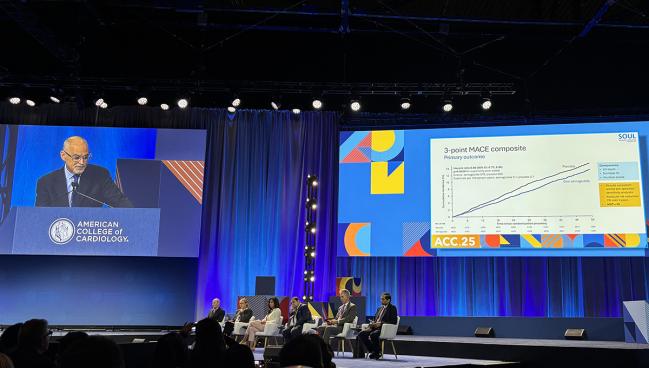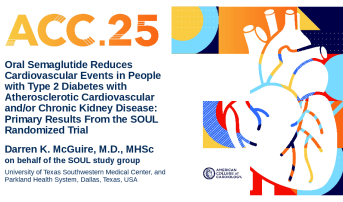SOUL: Oral Semaglutide Bests Usual Care in High-Risk Type 2 Diabetes
(UPDATE) Injectable semaglutide has better bioavailability, researchers say, but the many patients who want an oral drug are an unmet need.

CHICAGO, IL—High-risk patients who have type 2 diabetes plus established atherosclerotic cardiovascular disease (ASCVD), chronic kidney disease (CKD), or both have significantly fewer major adverse cardiovascular events when treated with an oral glucagon-like peptide 1 (GLP-1) receptor agonist compared with usual care, the SOUL trial shows.
Oral semaglutide (Rybelsus; Novo Nordisk) taken once daily cut the risk of cardiovascular mortality, nonfatal MI, or nonfatal stroke in the trial by 14% after a mean follow-up of 47.5 months, a benefit driven by the reduction in nonfatal MI.
“Semaglutide originally came to market as a once-weekly injectable where it's now approved for use for the treatment of hyperglycemia and to reduce cardiovascular risk in people with type two diabetes,” lead SOUL investigator Darren McGuire, MD (UT Southwestern Medical Center, Dallas, TX), said during a morning press conference at the American College of Cardiology (ACC) Scientific Session. “But as clinicians, we have many patients and even clinician prescribers who are reticent, or even resistant, to using injectable therapies.”
Prescribing injectable medications is not a common occurrence in a cardiology clinic, he added. While there has been an increase in the number of medications available as injections, such as PCSK9 inhibitors, these still represent a minority of drugs.
“The reality is the injections, they're usually 32- or 35-gauge needles and you literally cannot feel them enter the skin,” McGuire told TCTMD. “It's not only that they don't hurt much:, you can't feel them enter the skin. But even in coaching the patients and the prescribers, I would guess it's over half of the people eligible will refuse the therapy just because they don't want to take an injection. This will answer an unmet clinical need that is way bigger than it really should be, if you use logic. This is a fear that we just haven't been able to overcome.”
SOUL, which was presented today in the ACC Late-Breaking Clinical Trial Session, was published simultaneously in the New England Journal of Medicine.
Benefits of Semaglutide Well Known
The US Food and Drug Administration requires that all new medications for type 2 diabetes clear a cardiovascular safety hurdle before approval, and oral semaglutide jumped over the bar in PIONEER 6. In the last several years, the cardiovascular benefits of injectable semaglutide also have become well documented.
In SUSTAIN-6, a 2-year trial of patients with type 2 diabetes at high risk for cardiovascular events, semaglutide reduced the risk of cardiovascular mortality, nonfatal MI, and nonfatal stroke when compared with placebo. In the FLOW trial, a study of patients with type 2 diabetes and CKD, treatment reduced the risk of cardiovascular causes and kidney-related outcomes compared with standard care over a median of 3.4 years. For those without diabetes, such as those with obesity and ASCVD in SELECT, semaglutide cut the risk of major adverse cardiovascular events after roughly 40 months of follow-up.
We have many patients and even clinician prescribers who are reticent, or even resistant, to using injectable therapies. Darren McGuire
SOUL, which was designed as a superiority study, included 9,650 patients (mean age 66 years; 28.9% female), of whom 70.7% had coronary artery disease, 23.1% had heart failure, 21.1% had cerebrovascular disease, and 15.7% had peripheral artery disease. CKD was present in 42.4% of patients, and roughly 27% had both ASCVD and CKD. More than 90% of all patients had hypertension, while the mean duration of type 2 diabetes was more than 14 years. More than one-quarter of patients were taking an SGLT2 inhibitor at baseline.
After 4 years of follow-up, the primary endpoint had occurred in 12.0% of patients treated with semaglutide compared with 13.8% of patients treated with placebo (HR 0.86; 95% CI 0.77-0.96). At 3 years, a prespecified analysis of primary outcome events showed an absolute difference of 2.0% favoring treatment with semaglutide. The number needed to treat to prevent one primary endpoint was 50.
Secondary confirmatory endpoints were tested in hierarchical order, starting with major kidney events, a composite of cardiovascular mortality, kidney-related mortality, ≥ 50% reduction in the estimated glomerular filtration rate (eGFR) from baseline, persistent eGFR < 15 ml/min/1.73m2, or initiation of long-term kidney-replacement therapy with dialysis or transplantation. The difference between treatments was not statistically significant, so SOUL investigators say all further endpoint analyses are exploratory and hypothesis-generating.
There was no difference in the risk of cardiovascular mortality, but there was a reduction in hospitalizations for acute or chronic limb ischemia (HR; 0.71; 95% CI 0.52-0.96). There was a 26% relative reduction in the risk of nonfatal MI with semaglutide (4.0% vs 5.2%), and coronary revascularization, which made up a number of supportive secondary outcomes, was lower in the semaglutide arm (HR 0.75; 95% CI 0.62-0.90).
Glycated hemoglobin levels, body weight, and high-sensitivity C-reactive protein levels were all improved with semaglutide. On average, patients treated with the oral GLP-1 receptor agonist lost 4.22 kg, or close to 10 lbs.
Gastrointestinal disorders, a commonly reported side effect with the drug when injected, were more common with semaglutide. Adverse events that led to stopping treatment occurred in 15.5% of patients treated with semaglutide and 11.6% in the placebo arm.
Preventive cardiologist Neha Pagidipati, MD (Duke University School of Medicine, Durham, NC), called SOUL an important clinical trial because it confirms the cardiovascular benefits of oral semaglutide hinted at in PIONEER-6, giving clinicians and patients confidence that the drug works as well as the injectable formulation.
In her practice, though, the injectable route has not been a deterrent to getting patients started on a GLP-1 receptor agonist.
“That being said, we know, and the data bears this out, there are some patients who really prefer an oral agent and they’re not interested in taking an injectable formulation,” said Pagidipati. “This is a very important tool to have in our armamentarium.”
She added that patients with type 2 diabetes and ASCVD and/or CKD are very common in clinical practice and are at very high risk for future clinical events. “There are a lot of patients out there who could potentially benefit from these agents and this gives us another option,” she said.
SOUL vs FLOW
Speaking to the difference in outcomes between FLOW, a study where semaglutide cut both cardiovascular risk and the progression of kidney disease, and SOUL, where there was no effect on major kidney events, McGuire said their trial included healthier patients. The mean eGFR levels at baseline in FLOW and SOUL were 47 and 74 ml/min/1.73 m2, respectively.
“This was simply a pretty healthy kidney population,” McGuire said. “Even though having chronic kidney disease was one of the isolated inclusion criteria, only 13% entered the trial with kidney disease and the average eGFR among those [with kidney disease] was still well above the entire study [group] of FLOW. Our interpretation is you have to have a certain amount of kidney disease to intervene on the disease. These people had relatively preserved kidney function.”
Roughly one-quarter of patients in both arms were taking an SGLT2 inhibitor at baseline, a percentage that rose to 50% by study’s end. A prespecified analysis of SOUL, published simultaneously in Circulation, showed that the benefit of treatment with semaglutide was independent of concomitant SGLT2 inhibitor therapy and appeared to be safe.
My patients can’t benefit from a drug they can’t afford. Gina Lundberg
Anu Lala, MD (Icahn School of Medicine at Mount Sinai, New York), who spoke following the late-breaking presentation, said that clinicians have been reluctant to prescribe GLP-1 receptor agonists alongside SGLT2 inhibitors. Although both drugs are recommended to reduce CVD risk in patients with type 2 diabetes and ASCVD, there is little evidence supporting their combined use. These new data, said Lala, suggest the effects of oral semaglutide appear consistent regardless of background SGLT2 inhibitor therapy.
Given the availability of an oral medication and injectable, Lala asked how prescribers should proceed when faced with a patient with type 2 diabetes and ASCVD and/or CKD.
“If they can take the injection and they have access to it, that’s the preferred route of delivery,” said McGuire, noting that bioavailability is 100% when injected. On the other hand, oral semaglutide has a low bioavailability at around 0.8% when using recommended dosing conditions.
Gina Lundberg, MD (Emory University, Atlanta, GA), who spoke with the media prior to the presentation, said that while GLP-1 receptor agonists are frequently referred to as weight-loss drugs, she emphasizes to patients they have much broader benefits, including cardiovascular disease prevention.
Lundberg highlighted several limitations of the new study, pointing out that the majority of patients were white males and that those randomized were relatively healthy in terms of cardiometabolic risk factors. That said, she was pleased to see there was a large percentage of statin use as well as ACE inhibitors/ARBs.
“It was good to see the patients who benefited were already taking guideline-directed medical therapies,” she said. One unmentioned variable in the presentation was the cost of oral semaglutide, which can run over $1,000 per month. “My patients can’t benefit from a drug they can’t afford,” she said. “I would love to know more about the predictions of costs in the future.”
Michael O’Riordan is the Managing Editor for TCTMD. He completed his undergraduate degrees at Queen’s University in Kingston, ON, and…
Read Full BioSources
McGuire DK, Marx, Mulvagh SL, et al. Oral semaglutide and cardiovascular risk outcomes in high-risk type 2 diabetes. N Engl J Med. 2025;Epub ahead of print.
Marx N, Deanfield JE, Mann JFE, et al. Oral semaglutide and cardiovascular outcomes in persons with type 2 diabetes, according to SGLT2 inhibitor use: prespecified analyses of the SOUL randomized trial. Circulation. 2025;Epub ahead of print.
Disclosures
- McGuire reports consulting fees from Novo Nordisk, AstraZeneca, Pfizer, Altimmune, Ventyx Pharmaceuticals, Bayer, Lexicon, Applied Therapeutics, Intercept Pharmaceuticals, Esperion, Lilly USA, Boehringer Ingelheim, NewAmsterdam, CSL Behring, Amgen, Neurotronics, Metsera, Kailera, and Alveus Pharma.






Comments